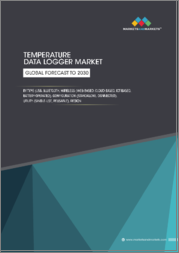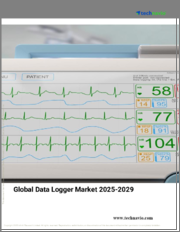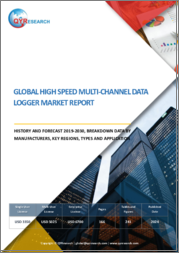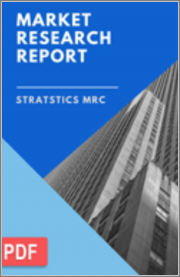
|
시장보고서
상품코드
1580071
데이터 로거 시장 : 입력 파라미터, 사용 모드, 최종사용자별 - 세계 예측(2025-2030년)Data Logger Market by Input Parameter (Humidity, Pressure, Temperature), Usage Mode (Portable, Stationary), End-user - Global Forecast 2025-2030 |
||||||
데이터 로거 시장의 2023년 시장 규모는 96억 3,000만 달러, 2024년에는 102억 7,000만 달러에 달할 것으로 예측되며, CAGR 7.13%로 성장하며, 2030년에는 156억 1,000만 달러에 달할 것으로 예측됩니다.
데이터 로거는 데이터 수집 시스템에 필수적인 장비로, 다양한 환경 파라미터를 장기간에 걸쳐 캡처하고 저장하는 데 매우 중요합니다. 환경 모니터링, 의료, 산업 자동화, 운송 등 다양한 분야에서 정확한 실시간 데이터 기록 및 분석은 운영의 성공에 필수적인 요소입니다. 최종 사용 범위에는 기상학, 농업, 제약, 빌딩 자동화 등의 산업이 포함됩니다. 디지털 전환이 가속화됨에 따라 IoT 통합과 데이터베이스 의사결정의 필요성으로 인해 지능형 데이터 로깅 시스템에 대한 수요가 급증하고 있습니다. 성장에 영향을 미치는 주요 요인으로는 무선통신 기술 발전, 센서 개발, 기기 작동 시간을 연장하는 배터리 기술 강화 등이 있습니다. 고속 데이터 캡처, 대용량 메모리, 연결 기능 등 급성장하는 IoT 동향과 동의어인 고급 기능을 갖춘 데이터 로거에 대한 수요가 증가하고 있습니다. 잠재적인 비즈니스 기회는 특정 산업의 요구에 맞는 맞춤형 솔루션을 제공하고, 다양한 부문으로 확장할 수 있으며, 클라우드 기반 플랫폼을 활용하여 데이터 분석 및 시각화 서비스를 향상시킬 수 있다는 점에서 찾을 수 있습니다. 하지만 시장 성장에 어려움이 없는 것은 아닙니다. 기술적으로 고도화된 데이터 로거의 높은 비용, 대량의 데이터를 효율적으로 관리하는 복잡성, 데이터 보안 및 프라이버시 우려 등이 큰 제약이 되고 있습니다. 이러한 문제를 극복하기 위해서는 저비용, 에너지 효율적이고 쉽게 통합할 수 있는 데이터 로깅 솔루션을 개발하기 위한 기술 혁신이 필요합니다. 무선 기능과 에지 컴퓨팅의 강화는 현재의 장애물을 무력화시킬 수 있습니다. 신소재와 나노 센서 기술의 연구는 제품의 소형화와 고감도화를 촉진하고 새로운 시장의 길을 열 수 있습니다. 시장 경쟁이 치열해짐에 따라 지속적인 연구개발 활동은 항상 한발 앞서 나가기 위한 기본입니다. 리더십을 추구하는 기업은 혁신을 촉진하고 시장 시야를 넓히기 위해 협력 파트너십과 전략적 제휴에 중점을 두어 비즈니스 성장과 시장 침투를 보장 할 수 있습니다.
| 주요 시장 통계 | |
|---|---|
| 기준년[2023년] | 96억 3,000만 달러 |
| 예측년[2024년] | 102억 7,000만 달러 |
| 예측년[2030년] | 156억 1,000만 달러 |
| CAGR(%) | 7.13% |
시장 역학: 빠르게 진화하는 데이터 로거 시장의 주요 시장 인사이트 공개
데이터 로거 시장은 수요 및 공급의 역동적인 상호작용을 통해 변화하고 있습니다. 이러한 시장 역학의 변화를 이해함으로써 기업은 정보에 입각한 투자 결정을 내리고, 전략적인 의사결정을 정교화하며, 새로운 비즈니스 기회를 포착할 수 있습니다. 이러한 동향을 종합적으로 파악함으로써 기업은 정치적, 지역적, 기술적, 사회적, 경제적 영역 전반에 걸친 다양한 리스크를 줄일 수 있으며, 소비자 행동과 그것이 제조 비용 및 구매 동향에 미치는 영향을 보다 명확하게 이해할 수 있습니다.
- 시장 성장 촉진요인
- 다양한 산업 분야의 모니터링 및 추적 용도에 대한 수요가 증가하고 있습니다.
- 산업계의 데이터 모니터링 및 문서화를 위한 엄격한 규제 기준과 컴플라이언스 준수
- 시장 성장 억제요인
- 고급형 데이터 로거의 높은 초기 투자 비용
- 시장 기회
- 데이터 로거의 정확도 향상 기술 발전
- 에너지 관리와 지속가능성에 대한 관심 증가
- 시장 과제
- 로거가 수집하는 데이터의 정확성과 신뢰성에 대한 우려
Portre's Five Forces: 데이터 로거 시장 공략을 위한 전략 툴
Portre's Five Forces 프레임워크는 시장 상황경쟁 구도를 이해하는 중요한 툴입니다. Portre's Five Forces 프레임워크는 기업의 경쟁을 평가하고 전략적 기회를 모색하기 위한 명확한 방법을 설명합니다. 이 프레임워크는 기업이 시장내 세력도를 평가하고 신규 사업의 수익성을 판단하는 데 도움이 됩니다. 이러한 인사이트을 통해 기업은 강점을 활용하고, 약점을 보완하고, 잠재적 도전을 피함으로써 보다 강력한 시장 포지셔닝을 확보할 수 있습니다.
PESTLE 분석 : 데이터 로거 시장의 외부 영향 파악
외부 거시 환경 요인은 데이터 로거 시장의 성과 역학을 형성하는 데 매우 중요한 역할을 합니다. 정치적, 경제적, 사회적, 기술적, 법적, 환경적 요인에 대한 분석은 이러한 영향을 탐색하는 데 필요한 정보를 담고 있으며, PESTLE 요인을 조사함으로써 기업은 잠재적인 위험과 기회를 더 잘 이해할 수 있습니다. 이러한 분석을 통해 기업은 규제, 소비자 선호도, 경제 동향의 변화를 예측하고 선제적이고 적극적인 의사결정을 내릴 준비를 할 수 있습니다.
시장 점유율 분석 데이터 로거 시장에서 경쟁 구도 파악
데이터 로거 시장의 상세한 시장 점유율 분석을 통해 벤더의 성과를 종합적으로 평가할 수 있습니다. 기업은 매출, 고객 기반, 성장률과 같은 주요 지표를 비교하여 경쟁적 위치를 파악할 수 있습니다. 이 분석은 시장의 집중화, 세분화 및 통합 추세를 파악하여 공급업체가 치열한 경쟁에서 자신의 입지를 강화할 수 있는 전략적 의사결정을 내리는 데 필요한 인사이트을 제공합니다.
FPNV 포지셔닝 매트릭스 데이터 로거 시장에서의 벤더 성능 평가
FPNV 포지셔닝 매트릭스는 데이터 로거 시장에서 벤더를 평가할 수 있는 중요한 툴입니다. 이 매트릭스를 통해 비즈니스 조직은 벤더의 비즈니스 전략과 제품 만족도를 기반으로 평가하여 목표에 부합하는 정보에 입각한 의사결정을 내릴 수 있으며, 4개의 사분면으로 벤더를 명확하고 정확하게 세분화하여 전략 목표에 가장 적합한 파트너와 솔루션을 식별할 수 있습니다. 전략 목표에 가장 적합한 파트너와 솔루션을 식별할 수 있습니다.
데이터 로거 시장에서 성공하기 위한 전략 분석 및 추천 데이터 로거 시장에서의 성공 경로를 그리다.
데이터 로거 시장의 전략적 분석은 세계 시장에서의 입지를 강화하고자 하는 기업에게 필수적입니다. 주요 자원, 역량 및 성과 지표를 검토함으로써 기업은 성장 기회를 식별하고 개선할 수 있습니다. 이러한 접근 방식을 통해 경쟁 환경의 도전을 극복하고 새로운 비즈니스 기회를 활용하여 장기적인 성공을 거둘 수 있도록 준비할 수 있습니다.
이 보고서는 주요 관심 부문에 대한 종합적인 시장 분석을 제공합니다.
1. 시장 침투도 : 현재 시장 환경의 상세한 검토, 주요 기업의 광범위한 데이터, 시장 도달 범위 및 전반적인 영향력 평가.
2. 시장 개척도: 신흥 시장에서의 성장 기회를 파악하고, 기존 부문의 확장 가능성을 평가하며, 미래 성장을 위한 전략적 로드맵을 기술하고 있습니다.
3. 시장 다각화 : 최근 제품 출시, 미개척 지역, 업계의 주요 발전, 시장을 형성하는 전략적 투자를 분석합니다.
4. 경쟁 평가 및 정보 : 경쟁 구도를 철저히 분석하여 시장 점유율, 사업 전략, 제품 포트폴리오, 인증, 규제 당국의 승인, 특허 동향, 주요 기업의 기술 발전 등을 검토합니다.
5. 제품 개발 및 혁신 : 미래 시장 성장을 가속할 것으로 예상되는 첨단 기술, 연구개발 활동 및 제품 혁신을 강조합니다.
또한 이해관계자들이 충분한 정보를 바탕으로 의사결정을 내릴 수 있도록 중요한 질문에 대한 답변도 제공합니다.
1. 현재 시장 규모와 향후 성장 전망은?
2. 최고의 투자 기회를 제공하는 제품, 지역은?
3. 시장을 형성하는 주요 기술 동향과 규제의 영향은?
4. 주요 벤더 시장 점유율과 경쟁 포지션은?
5.벤더 시장 진입 및 철수 전략의 원동력이 되는 수입원과 전략적 기회는 무엇인가?
목차
제1장 서문
제2장 조사 방법
제3장 개요
제4장 시장 개요
제5장 시장 인사이트
- 시장 역학
- 성장 촉진요인
- 성장 억제요인
- 기회
- 과제
- 시장 세분화 분석
- Porter's Five Forces 분석
- PESTEL 분석
- 정치
- 경제
- 사회
- 기술
- 법률
- 환경
제6장 데이터 로거 시장 : 입력 파라미터별
- 서론
- 습도
- 압력
- 온도
- 전압
제7장 데이터 로거 시장 : 사용 모드별
- 서론
- 휴대용
- 고정형
제8장 데이터 로거 시장 : 최종사용자별
- 서론
- 에너지·유틸리티
- 식품 및 음료
- 제조업
- 의약품
- 운송
제9장 아메리카의 데이터 로거 시장
- 서론
- 아르헨티나
- 브라질
- 캐나다
- 멕시코
- 미국
제10장 아시아태평양의 데이터 로거 시장
- 서론
- 호주
- 중국
- 인도
- 인도네시아
- 일본
- 말레이시아
- 필리핀
- 싱가포르
- 한국
- 대만
- 태국
- 베트남
제11장 유럽, 중동 및 아프리카의 데이터 로거 시장
- 서론
- 덴마크
- 이집트
- 핀란드
- 프랑스
- 독일
- 이스라엘
- 이탈리아
- 네덜란드
- 나이지리아
- 노르웨이
- 폴란드
- 카타르
- 러시아
- 사우디아라비아
- 남아프리카공화국
- 스페인
- 스웨덴
- 스위스
- 터키
- 아랍에미리트
- 영국
제12장 경쟁 구도
- 시장 점유율 분석, 2023년
- FPNV 포지셔닝 매트릭스, 2023년
- 경쟁 시나리오 분석
- 전략 분석과 제안
언급된 기업
- ABB Ltd.
- Brainchild Electronics Co.,Ltd.
- Danlaw Inc.
- Delphin Technology AG
- Dewesoft d.o.o.
- Dickson Data Corporate Entity
- HEM Data Corporation
- In-Situ Inc.
- Influx Technology LTD
- Intrepid Control Systems, Inc.
- Ipetronik GmbH & Co. KG.
- Lascar Electronics Limited
- Mesa Labs, Inc.
- MicroDAQ, LLC
- NSM Solutions
- Omega Engineering, Inc.
- Pico Technology Ltd.
- Racelogic Ltd.
- Robert Bosch GmbH
- Thermo Fisher Scientific Inc.
- Transtron Inc.
- TTTech Computertechnik AG
- Vector Informatik GmbH
- Xylon
The Data Logger Market was valued at USD 9.63 billion in 2023, expected to reach USD 10.27 billion in 2024, and is projected to grow at a CAGR of 7.13%, to USD 15.61 billion by 2030.
A Data Logger is an essential device in data acquisition systems, crucial for capturing and storing various environmental parameters over time. It is highly necessary in multiple applications, including environmental monitoring, healthcare, industrial automation, and transport, where precise real-time data recording and analysis are crucial for operational success. The end-use scope encompasses industries such as meteorology, agriculture, pharmaceuticals, and building automation. As digital transformation accelerates, the demand for intelligent data logging systems is soaring, driven by IoT integration and the necessity for data-driven decision-making. Key influencing growth factors include technological advancements in wireless communication, sensor development, and enhanced battery technologies prolonging device operation time. There is a growing demand for data loggers with advanced capabilities such as high-speed data capture, large memory capacity, and connectivity features synonymous with burgeoning IoT trends. Potential opportunities lie in offering customized solutions tailored to specific industry needs, scalable across various sectors, and leveraging cloud-based platforms for improved data analytics and visualization services. However, market growth is not without its challenges. The high cost of technologically advanced data loggers, complexities in effectively managing massive amounts of data, and concerns over data security and privacy pose significant limitations. To navigate these challenges, innovation should be channeled towards developing low-cost, energy-efficient, and easily integrable data logging solutions. Enhancement in wireless capability and edge computing can also nullify some current hindrances. Research into novel materials and nano-sensor technology can drive product miniaturization and higher sensitivity, thus opening new market avenues. As the market is increasingly competitive, continuous research and development activities are fundamental to stay ahead. Companies aiming for leadership should focus on collaborative partnerships and strategic alliances to foster innovation and expand their market horizons, thereby ensuring business growth and market penetration.
| KEY MARKET STATISTICS | |
|---|---|
| Base Year [2023] | USD 9.63 billion |
| Estimated Year [2024] | USD 10.27 billion |
| Forecast Year [2030] | USD 15.61 billion |
| CAGR (%) | 7.13% |
Market Dynamics: Unveiling Key Market Insights in the Rapidly Evolving Data Logger Market
The Data Logger Market is undergoing transformative changes driven by a dynamic interplay of supply and demand factors. Understanding these evolving market dynamics prepares business organizations to make informed investment decisions, refine strategic decisions, and seize new opportunities. By gaining a comprehensive view of these trends, business organizations can mitigate various risks across political, geographic, technical, social, and economic domains while also gaining a clearer understanding of consumer behavior and its impact on manufacturing costs and purchasing trends.
- Market Drivers
- Rising demand for monitoring and tracking applications across various industries
- Stringent regulatory standards and compliance for data monitoring and documentation in industries
- Market Restraints
- High cost of initial investment for advanced data loggers
- Market Opportunities
- Advancement technologies in data loggers to enhance its accuracy
- Increasing focus on energy management and sustainability
- Market Challenges
- Concerns about data accuracy and reliability of data collected by loggers
Porter's Five Forces: A Strategic Tool for Navigating the Data Logger Market
Porter's five forces framework is a critical tool for understanding the competitive landscape of the Data Logger Market. It offers business organizations with a clear methodology for evaluating their competitive positioning and exploring strategic opportunities. This framework helps businesses assess the power dynamics within the market and determine the profitability of new ventures. With these insights, business organizations can leverage their strengths, address weaknesses, and avoid potential challenges, ensuring a more resilient market positioning.
PESTLE Analysis: Navigating External Influences in the Data Logger Market
External macro-environmental factors play a pivotal role in shaping the performance dynamics of the Data Logger Market. Political, Economic, Social, Technological, Legal, and Environmental factors analysis provides the necessary information to navigate these influences. By examining PESTLE factors, businesses can better understand potential risks and opportunities. This analysis enables business organizations to anticipate changes in regulations, consumer preferences, and economic trends, ensuring they are prepared to make proactive, forward-thinking decisions.
Market Share Analysis: Understanding the Competitive Landscape in the Data Logger Market
A detailed market share analysis in the Data Logger Market provides a comprehensive assessment of vendors' performance. Companies can identify their competitive positioning by comparing key metrics, including revenue, customer base, and growth rates. This analysis highlights market concentration, fragmentation, and trends in consolidation, offering vendors the insights required to make strategic decisions that enhance their position in an increasingly competitive landscape.
FPNV Positioning Matrix: Evaluating Vendors' Performance in the Data Logger Market
The Forefront, Pathfinder, Niche, Vital (FPNV) Positioning Matrix is a critical tool for evaluating vendors within the Data Logger Market. This matrix enables business organizations to make well-informed decisions that align with their goals by assessing vendors based on their business strategy and product satisfaction. The four quadrants provide a clear and precise segmentation of vendors, helping users identify the right partners and solutions that best fit their strategic objectives.
Strategy Analysis & Recommendation: Charting a Path to Success in the Data Logger Market
A strategic analysis of the Data Logger Market is essential for businesses looking to strengthen their global market presence. By reviewing key resources, capabilities, and performance indicators, business organizations can identify growth opportunities and work toward improvement. This approach helps businesses navigate challenges in the competitive landscape and ensures they are well-positioned to capitalize on newer opportunities and drive long-term success.
Key Company Profiles
The report delves into recent significant developments in the Data Logger Market, highlighting leading vendors and their innovative profiles. These include ABB Ltd., Brainchild Electronics Co.,Ltd., Danlaw Inc., Delphin Technology AG, Dewesoft d.o.o., Dickson Data Corporate Entity, HEM Data Corporation, In-Situ Inc., Influx Technology LTD, Intrepid Control Systems, Inc., Ipetronik GmbH & Co. KG., Lascar Electronics Limited, Mesa Labs, Inc., MicroDAQ, LLC, NSM Solutions, Omega Engineering, Inc., Pico Technology Ltd., Racelogic Ltd., Robert Bosch GmbH, Thermo Fisher Scientific Inc., Transtron Inc., TTTech Computertechnik AG, Vector Informatik GmbH, and Xylon.
Market Segmentation & Coverage
This research report categorizes the Data Logger Market to forecast the revenues and analyze trends in each of the following sub-markets:
- Based on Input Parameter, market is studied across Humidity, Pressure, Temperature, and Voltage.
- Based on Usage Mode, market is studied across Portable and Stationary.
- Based on End-user, market is studied across Energy & Utilities, Food & Beverage, Manufacturing, Pharmaceuticals, and Transportation.
- Based on Region, market is studied across Americas, Asia-Pacific, and Europe, Middle East & Africa. The Americas is further studied across Argentina, Brazil, Canada, Mexico, and United States. The United States is further studied across California, Florida, Illinois, New York, Ohio, Pennsylvania, and Texas. The Asia-Pacific is further studied across Australia, China, India, Indonesia, Japan, Malaysia, Philippines, Singapore, South Korea, Taiwan, Thailand, and Vietnam. The Europe, Middle East & Africa is further studied across Denmark, Egypt, Finland, France, Germany, Israel, Italy, Netherlands, Nigeria, Norway, Poland, Qatar, Russia, Saudi Arabia, South Africa, Spain, Sweden, Switzerland, Turkey, United Arab Emirates, and United Kingdom.
The report offers a comprehensive analysis of the market, covering key focus areas:
1. Market Penetration: A detailed review of the current market environment, including extensive data from top industry players, evaluating their market reach and overall influence.
2. Market Development: Identifies growth opportunities in emerging markets and assesses expansion potential in established sectors, providing a strategic roadmap for future growth.
3. Market Diversification: Analyzes recent product launches, untapped geographic regions, major industry advancements, and strategic investments reshaping the market.
4. Competitive Assessment & Intelligence: Provides a thorough analysis of the competitive landscape, examining market share, business strategies, product portfolios, certifications, regulatory approvals, patent trends, and technological advancements of key players.
5. Product Development & Innovation: Highlights cutting-edge technologies, R&D activities, and product innovations expected to drive future market growth.
The report also answers critical questions to aid stakeholders in making informed decisions:
1. What is the current market size, and what is the forecasted growth?
2. Which products, segments, and regions offer the best investment opportunities?
3. What are the key technology trends and regulatory influences shaping the market?
4. How do leading vendors rank in terms of market share and competitive positioning?
5. What revenue sources and strategic opportunities drive vendors' market entry or exit strategies?
Table of Contents
1. Preface
- 1.1. Objectives of the Study
- 1.2. Market Segmentation & Coverage
- 1.3. Years Considered for the Study
- 1.4. Currency & Pricing
- 1.5. Language
- 1.6. Stakeholders
2. Research Methodology
- 2.1. Define: Research Objective
- 2.2. Determine: Research Design
- 2.3. Prepare: Research Instrument
- 2.4. Collect: Data Source
- 2.5. Analyze: Data Interpretation
- 2.6. Formulate: Data Verification
- 2.7. Publish: Research Report
- 2.8. Repeat: Report Update
3. Executive Summary
4. Market Overview
5. Market Insights
- 5.1. Market Dynamics
- 5.1.1. Drivers
- 5.1.1.1. Rising demand for monitoring and tracking applications across various industries
- 5.1.1.2. Stringent regulatory standards and compliance for data monitoring and documentation in industries
- 5.1.2. Restraints
- 5.1.2.1. High cost of initial investment for advanced data loggers
- 5.1.3. Opportunities
- 5.1.3.1. Advancement technologies in data loggers to enhance its accuracy
- 5.1.3.2. Increasing focus on energy management and sustainability
- 5.1.4. Challenges
- 5.1.4.1. Concerns about data accuracy and reliability of data collected by loggers
- 5.1.1. Drivers
- 5.2. Market Segmentation Analysis
- 5.2.1. Input Parameter: Need for humidity data loggers to maintain optimum product quality
- 5.2.2. End-user: Emerging adoption of data loggers in the energy and utilities sector to ensure monitoring of energy consumption
- 5.3. Porter's Five Forces Analysis
- 5.3.1. Threat of New Entrants
- 5.3.2. Threat of Substitutes
- 5.3.3. Bargaining Power of Customers
- 5.3.4. Bargaining Power of Suppliers
- 5.3.5. Industry Rivalry
- 5.4. PESTLE Analysis
- 5.4.1. Political
- 5.4.2. Economic
- 5.4.3. Social
- 5.4.4. Technological
- 5.4.5. Legal
- 5.4.6. Environmental
6. Data Logger Market, by Input Parameter
- 6.1. Introduction
- 6.2. Humidity
- 6.3. Pressure
- 6.4. Temperature
- 6.5. Voltage
7. Data Logger Market, by Usage Mode
- 7.1. Introduction
- 7.2. Portable
- 7.3. Stationary
8. Data Logger Market, by End-user
- 8.1. Introduction
- 8.2. Energy & Utilities
- 8.3. Food & Beverage
- 8.4. Manufacturing
- 8.5. Pharmaceuticals
- 8.6. Transportation
9. Americas Data Logger Market
- 9.1. Introduction
- 9.2. Argentina
- 9.3. Brazil
- 9.4. Canada
- 9.5. Mexico
- 9.6. United States
10. Asia-Pacific Data Logger Market
- 10.1. Introduction
- 10.2. Australia
- 10.3. China
- 10.4. India
- 10.5. Indonesia
- 10.6. Japan
- 10.7. Malaysia
- 10.8. Philippines
- 10.9. Singapore
- 10.10. South Korea
- 10.11. Taiwan
- 10.12. Thailand
- 10.13. Vietnam
11. Europe, Middle East & Africa Data Logger Market
- 11.1. Introduction
- 11.2. Denmark
- 11.3. Egypt
- 11.4. Finland
- 11.5. France
- 11.6. Germany
- 11.7. Israel
- 11.8. Italy
- 11.9. Netherlands
- 11.10. Nigeria
- 11.11. Norway
- 11.12. Poland
- 11.13. Qatar
- 11.14. Russia
- 11.15. Saudi Arabia
- 11.16. South Africa
- 11.17. Spain
- 11.18. Sweden
- 11.19. Switzerland
- 11.20. Turkey
- 11.21. United Arab Emirates
- 11.22. United Kingdom
12. Competitive Landscape
- 12.1. Market Share Analysis, 2023
- 12.2. FPNV Positioning Matrix, 2023
- 12.3. Competitive Scenario Analysis
- 12.3.1. ACR Systems Inc. Launches Innovative Self-Powered Data Loggers to Enhance Monitoring and Sustainability in Electrical and Industrial Markets
- 12.3.2. New Liebherr Medical and Research Appliances Boost Connectivity and Monitoring with SmartModule and Testo Solutions Partnership
- 12.3.3. Onset Launches Customizable HOBO MX800 Bluetooth Data Loggers with Interchangeable Sensors for Enhanced Water Quality Monitoring
- 12.4. Strategy Analysis & Recommendation
Companies Mentioned
- 1. ABB Ltd.
- 2. Brainchild Electronics Co.,Ltd.
- 3. Danlaw Inc.
- 4. Delphin Technology AG
- 5. Dewesoft d.o.o.
- 6. Dickson Data Corporate Entity
- 7. HEM Data Corporation
- 8. In-Situ Inc.
- 9. Influx Technology LTD
- 10. Intrepid Control Systems, Inc.
- 11. Ipetronik GmbH & Co. KG.
- 12. Lascar Electronics Limited
- 13. Mesa Labs, Inc.
- 14. MicroDAQ, LLC
- 15. NSM Solutions
- 16. Omega Engineering, Inc.
- 17. Pico Technology Ltd.
- 18. Racelogic Ltd.
- 19. Robert Bosch GmbH
- 20. Thermo Fisher Scientific Inc.
- 21. Transtron Inc.
- 22. TTTech Computertechnik AG
- 23. Vector Informatik GmbH
- 24. Xylon

















